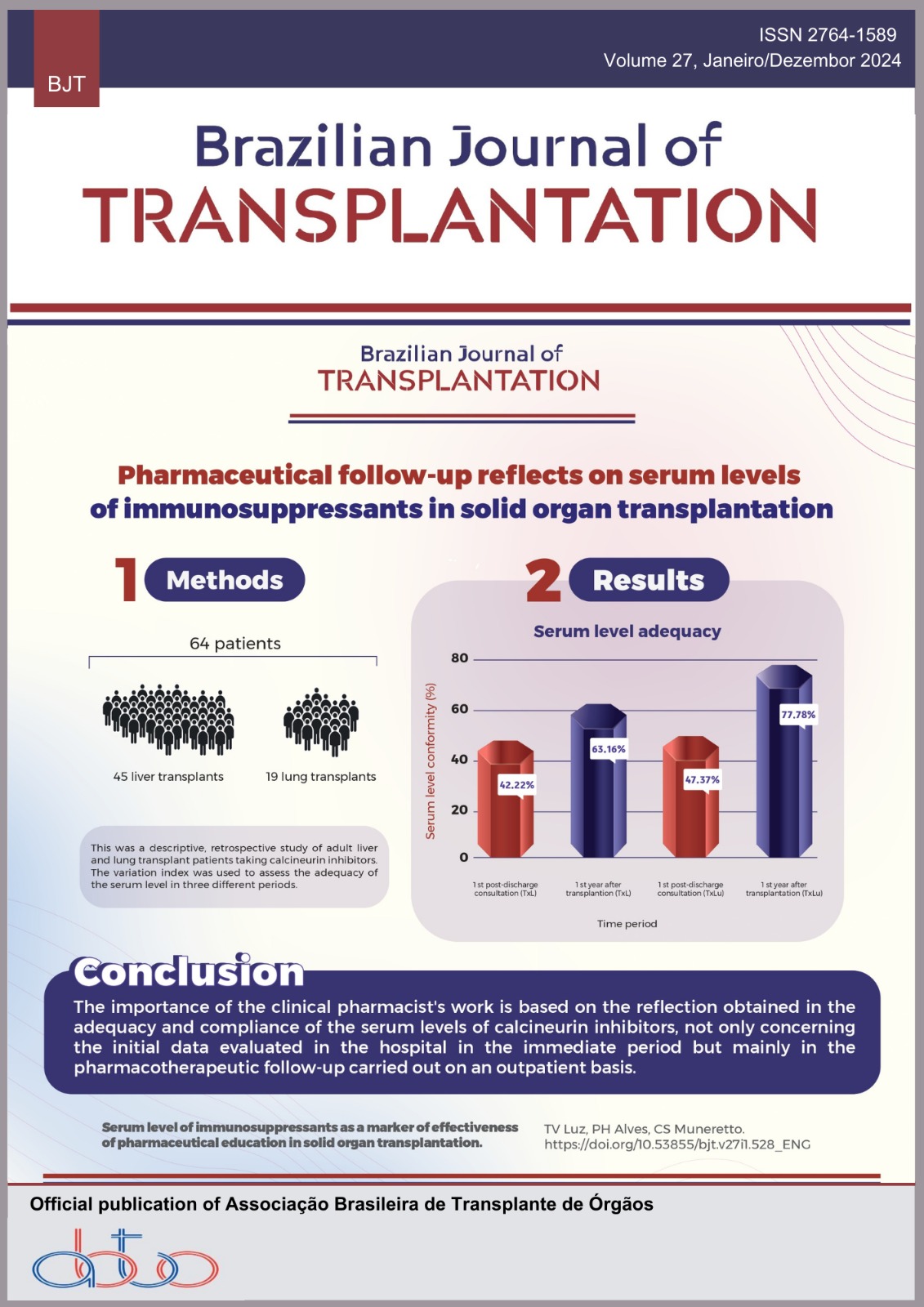Desinfecção por Vapor de Peróxido de Hidrogênio no Transplante de Fígado: Efeitos na Colonização de Organismos Multirresistentes e nos Resultados do Receptor
Palavras-chave:
Transplante de Fígado, Organismos Multirresistentes, Infecções Associadas aos Cuidados de Saúde, Contaminação AmbientalResumo
Introdução: A escalada das infecções por organismos multirresistentes (MR) pós-transplante de fígado (TF) representa riscos significativos, com a colonização por MR amplificando a suscetibilidade à infecção. A desinfecção ambiental é crucial para conter as infecções associadas à assistência à saúde (IRAS). A tecnologia de vapor de peróxido de hidrogênio (VPH) oferece promessas, mas seu impacto nas infecções por MR e nos resultados dos pacientes ainda não está claro. Métodos: Um estudo de coorte incluiu 58 receptores de TF adultos, comparando os resultados antes e depois da implementação rotineira do VPH. A desinfecção por VPH seguiu a limpeza terminal em salas cirúrgicas e boxes de unidade de terapia intensiva. Os dados dos patógenos incluíram colonização por MR no pré- e pós-transplante. Os dados clínicos abrangeram características dos receptores, gravidade da doença e características do binômio doador-receptor. As análises estatísticas avaliaram associações e resultados. Resultados: Vinte e sete pacientes estavam no grupo antes do VPH e 24 no grupo após o VPH. As características demográficas e clínicas foram comparáveis entre os grupos. A implementação do VPH aumentou significativamente a probabilidade de resultados negativos nos swabs de controle (razão de chances 2,33). Klebsiella pneumoniae carbapenemase foi o patógeno mais frequente, com infecções do sítio cirúrgico sendo o local primário mais comum. Pacientes com swabs negativos tiveram internações hospitalares mais curtas (diferença média de 10,54 dias), divergindo notadamente por volta do 8o dia de internação. A frequência de IRAS e a mortalidade em 90 dias foram significativamente menores em pacientes com swabs negativos. Conclusão: A tecnologia de VPH reduziu efetivamente a colonização por MR em receptores de TF. Swabs negativos se correlacionaram com internações hospitalares mais curtas e menor frequência de IRAS, impactando positivamente a mortalidade em 90 dias. Apesar dos desafios na implementação do VPH, sua eficácia na redução da colonização por MR sugere uma ferramenta valiosa nas estratégias de controle de infecções para populações vulneráveis como receptores de TF.
Downloads
Referências
Pouch SM, Patel G, Practice ASTIDCo. Multidrug-resistant Gram-negative bacterial infections in solid organ transplant recipients – Guidelines from the American Society of Transplantation Infectious Diseases Community of Practice. Clin Transplant. 2019; 33(9): e13594. https://doi.org/10.1111/ctr.13594
Hand J, Patel G. Multidrug-resistant organisms in liver transplant: mitigating risk and managing infections. Liver Transpl. 2016; 22(8): 1143-53.
Ferrarese A, Senzolo M, Sasset L, Bassi D, Cillo U, Burra P. Multidrug-resistant bacterial infections in the liver transplant setting. Updates in Surgery. 2024. https://doi.org/10.1007/s13304-024-01903-6
Suleyman G, Alangaden G, Bardossy AC. The role of environmental contamination in the transmission of nosocomial pathogens and healthcare-associated infections. Curr Infect Dis Rep. 2018; 20(6): 12. https://doi.org/10.1007/s11908-018- 0620-2
Anderson DJ, Chen LF, Weber DJ, Moehring RW, Lewis SS, Triplett PF, et al. Enhanced terminal room disinfection and acquisition and infection caused by multidrug-resistant organisms and Clostridium difficile (the benefits of enhanced terminal room disinfection study): a cluster-randomised, multicentre, crossover study. Lancet. 2017; 389(10071): 805-14.
Weinstein RA. Epidemiology and control of nosocomial infections in adult intensive care units. Am J Med. 1991; (3). https://doi.org/10.1016/0002-9343(91)90366-6
Porto APM, Tavares BM, de Assis DB, Mendes ET, Girao ES, Perdigao Neto LV, et al. Brazilian perspective: antimicrobial stewardship in solid organ transplant. Transpl Infect Dis. 2022; 24(5): e13874. https://doi.org/10.1111/tid.13874
Naghavi M, Vollset SE, Ikuta KS, Swetschinski LR, Gray AP, Wool EE, et al. Global burden of bacterial antimicrobial resistance: a systematic analysis with forecasts to 2050. The Lancet. 2024;404(10459):1199 - 226.
McDonald LC, Arduino M. Editorial commentary: climbing the evidentiary hierarchy for environmental infection control. Clin Infect Dis. 2013;5 6(1): 36-9. https://doi.org/10.1093/cid/cis845
van der Starre CM, Cremers-Pijpers SAJ, van Rossum C, Bowles EC, Tostmann A. The in situ efficacy of whole room disinfection devices: a literature review with practical recommendations for implementation. Antimicrob Resist Infect Control. 2022; 11(1): 149. https://doi.org/10.1186/s13756-022-01183-y
Huttner BD, Harbarth S. Hydrogen peroxide room disinfection--ready for prime time? Crit Care. 2015; 19(1): 216. https://doi.org/10.1186/s13054-015-0915-8
Passaretti CL, Otter JA, Reich NG, Myers J, Shepard J, Ross T, et al. An evaluation of environmental decontamination with hydrogen peroxide vapor for reducing the risk of patient acquisition of multidrug resistant organisms. Clin Infect Dis. 2013; 56(1): 27-35. https://doi.org/10.1093/cid/cis839
Comitê Brasileiro de Testes de Sensibilidade aos Antimicrobianos. 2024. Available from: https://brcast.org.br/. Accessed on Sept. 24.
Durand F, Buyse S, Francoz C, Laouenan C, Bruno O, Belghiti J, et al. Prognostic value of muscle atrophy in cirrhosis using psoas muscle thickness on computed tomography. J Hepatol. 2014; 60(6): 1151-7. https://doi.org/10.1016/j.jhep.2014.02.026
Olthoff KM, Kulik L, Samstein B, Kaminski M, Abecassis M, Emond J, et al. Validation of a current definition of early allograft dysfunction in liver transplant recipients and analysis of risk factors. Liver Transpl. 2010; 16(8): 943-9. https://doi.org/10.1002/lt.22091
World Healgh Organization. Hand hygiene technical reference manual: to be used by health-care workers, trainers and observers of hand hygiene practices. WHO Library Cataloguing-in-Publication Data; 2009.
Dean AGAT, Sunki GG, Friedman R, Lantinga M, Sangam S, Zubieta JC, et al. EpiInfoTM, a database and statistics program for public health professionals. Atlanta: CDC; 2011.
Julius. 2024. Julius AI. 4.0. Available from: https://julius.ai/. Accessed on Sept. 24.
Ferstl PG, Filmann N, Heilgenthal EM, Schnitzbauer AA, Bechstein WO, Kempf VAJ, et al. Colonization with multidrug- resistant organisms is associated with in increased mortality in liver transplant candidates. PLoS One. 2021;16(1): e0245091. https://doi.org/10.1371/journal.pone.0245091
Lemos GT, Terrabuio DRB, Nunes NN, Song ATW, Oshiro ICV, D'Albuquerque LAC, et al. Pre-transplant multidrug- resistant infections in liver transplant recipients-epidemiology and impact on transplantation outcome. Clin Transplant. 2024; 38(1):e 15173. https://doi.org/10.1111/ctr.15173
Leibovici-Weissman Y, Anchel N, Nesher E, Leshno M, Shlomai A. Early post-liver transplantation infections and their effect on long-term survival. Transpl Infect Dis. 2021; 23(4): e13673. https://doi.org/10.1111/tid.13673
Freire MP, Oshiro IC, Pierrotti LC, Bonazzi PR, de Oliveira LM, Song AT, et al. Carbapenem-resistant enterobacteriaceae acquired before liver transplantation: impact on recipient outcomes. Transplantation. 2017; 101(4): 811-20. https://doi.org/10.1097/TP.0000000000001620
O'Neill J, Resistance RoA, Trust W. Tackling drug-resistant infections globally: final report and recommendations: Review on Antimicrobial Resistance; 2016.
Silveira F, Silveira FP, Freitas ACT, Coelho JCU, Ramos EJB, Macri MM, et al. Liver transplantation: survival and indexes of donor-recipient matching. Rev Assoc Med Bras. 2021; 67(5): 690-5. https://doi.org/10.1590/1806-9282.20201088
Dutkowski P, Oberkofler CE, Slankamenac K, Puhan MA, Schadde E, Mullhaupt B, et al. Are there better guidelines for allocation in liver transplantation? A novel score targeting justice and utility in the model for end-stage liver disease era. Ann Surg. 2011; 254(5): 745-53. https://doi.org/10.1097/SLA.0b013e3182365081
Otter JA, Yezli S, French GL. The role played by contaminated surfaces in the transmission of nosocomial pathogens. Infect Control Hosp Epidemiol. 2011; 32(7): 687-99. https://doi.org/10.1086/660363
Weber DJ, Rutala WA, Anderson DJ, Chen LF, Sickbert-Bennett EE, Boyce JM. Effectiveness of ultraviolet devices and hydrogen peroxide systems for terminal room decontamination: focus on clinical trials. Am J Infect Control. 2016; 44(5 Suppl): e77-84. https://doi.org/10.1016/j.ajic.2015.11.015
Manian FA, Griesenauer S, Senkel D, Setzer JM, Doll SA, Perry AM, et al. Isolation of Acinetobacter baumannii complex and methicillin-resistant Staphylococcus aureus from hospital rooms following terminal cleaning and disinfection: can we do better? Infect Control Hosp Epidemiol. 2011; 32(7): 667-72. https://doi.org/10.1086/660357
Chen N, Li Y, He W, Chen X, Cheng F, Cheng X, et al. Clinical effectiveness of a 3-step versus a 6-step hand hygiene technique: a randomized controlled cross-over study. Open Forum Infectious Diseases. 2024; 11(10). https://doi.org/10.1093/ofid/ofae534
Carling PC, Parry MF, Bruno-Murtha LA, Dick B. Improving environmental hygiene in 27 intensive care units to decrease multidrug-resistant bacterial transmission. Crit Care Med. 2010; 38(4): 1054-9. https://doi.org/10.1097/CCM.0b013e3181cdf705
Chen LF, Knelson LP, Gergen MF, Better OM, Nicholson BP, Woods CW, et al. A prospective study of transmission of multidrug-resistant organisms (MDROs) between environmental sites and hospitalized patients-the TransFER study. Infect Control Hosp Epidemiol. 2019; 40(1): 47-52. https://doi.org/10.1017/ice.2018.275
Drees M, Snydman DR, Schmid CH, Barefoot L, Hansjosten K, Vue PM, et al. Prior environmental contamination increases the risk of acquisition of vancomycin-resistant enterococci. Clin Infect Dis. 2008; 46(5): 678-85. https://doi.org/10.1086/527394
French GL, Otter JA, Shannon KP, Adams NM, Watling D, Parks MJ. Tackling contamination of the hospital environment by methicillin-resistant Staphylococcus aureus (MRSA): a comparison between conventional terminal cleaning and hydrogen peroxide vapour decontamination. J Hosp Infect. 2004; 57(1): 31-7. https://doi.org/10.1016/j.jhin.2004.03.006
Strassle P, Thom KA, Johnson JK, Leekha S, Lissauer M, Zhu J, et al. The effect of terminal cleaning on environmental contamination rates of multidrug-resistant Acinetobacter baumannii. Am J Infect Control. 2012; 40(10): 1005-7. https://doi.org/10.1016/j.ajic.2012.05.027
Kim SH, Kim GR, Kim EY, Jeong J, Kim S, Shin JH. Carbapenemase-producing Eenterobacterales from hospital environment and their relation to those from patient specimens. J Infect Public Health. 2022; 15(2): 241-4. https://doi.org/10.1016/j.jiph.2022.01.002
Thoma R, Seneghini M, Seiffert SN, Vuichard Gysin D, Scanferla G, Haller S, et al. The challenge of preventing and containing outbreaks of multidrug-resistant organisms and Candida auris during the coronavirus disease 2019 pandemic: report of a carbapenem-resistant Acinetobacter baumannii outbreak and a systematic review of the literature. Antimicrob Resist Infect Control. 2022; 11(1): 12. https://doi.org/10.1186/s13756-022-01052-8
Falagas ME, Thomaidis PC, Kotsantis IK, Sgouros K, Samonis G, Karageorgopoulos DE. Airborne hydrogen peroxide for disinfection of the hospital environment and infection control: a systematic review. J Hosp Infect. 2011; 78(3): 171-7. https://doi.org/10.1016/j.jhin.2010.12.006
Blazejewski C, Wallet F, Rouze A, Le Guern R, Ponthieux S, Salleron J, et al. Efficiency of hydrogen peroxide in improving disinfection of ICU rooms. Crit Care. 2015; 19(1): 30. https://doi.org/10.1186/s13054-015-0752-9
Lemmen S, Scheithauer S, Hafner H, Yezli S, Mohr M, Otter JA. Evaluation of hydrogen peroxide vapor for the inactivation of nosocomial pathogens on porous and nonporous surfaces. Am J Infect Control. 2015; 43(1): 82-5. https://doi.org/10.1016/j.ajic.2014.10.007
Rutala WA, Weber DJ. Are room decontamination units needed to prevent transmission of environmental pathogens? Infect Control Hosp Epidemiol. 2011; 32(8): 743-7. https://doi.org/10.1086/661226
Marra AR, Schweizer ML, Edmond MB. No-touch disinfection methods to decrease multidrug-resistant organism infections: a systematic review and meta-analysis. Infect Control Hosp Epidemiol. 2018; 39(1): 20-31. https://doi.org/10.1017/ice.2017.226
Giannella M, Bartoletti M, Morelli MC, Tedeschi S, Cristini F, Tumietto F, et al. Risk factors for infection with carbapenem- resistant Klebsiella pneumoniae after liver transplantation: the importance of pre- and posttransplant colonization. Am J Transplant. 2015; 15(6): 1708-15. https://doi.org/10.1111/ajt.13136
Giannella M, Bartoletti M, Campoli C, Rinaldi M, Coladonato S, Pascale R, et al. The impact of carbapenemase-producing Enterobacteriaceae colonization on infection risk after liver transplantation: a prospective observational cohort study. Clin Microbiol Infect. 2019; 25(12): 1525-31. https://doi.org/10.1016/j.cmi.2019.04.014
Falcone M, Tiseo G, Galfo V, Giordano C, Leonildi A, Marciano E, et al. Bloodstream infections in patients with rectal colonization by Klebsiella pneumoniae producing different type of carbapenemases: a prospective, cohort study (CHIMERA study). Clin Microbiol Infect. 2022; 28(2): 298 e1-7. https://doi.org/10.1016/j.cmi.2021.06.031
Kim YJ, Kim SI, Choi JY, Yoon SK, You YK, Kim DG. Clinical significance of methicillin-resistant Staphylococcus aureus and vancomycin-resistant enterococci colonization in liver transplant recipients. Korean J Intern Med. 2015; 30(5): 694-704. https://doi.org/10.3904%2Fkjim.2015.30.5.694
Freire MP, Van Der Heijden IM, do Prado GV, Cavalcante LS, Boszczowski I, Bonazzi PR, et al. Polymyxin use as a risk factor for colonization or infection with polymyxin-resistant Acinetobacter baumannii after liver transplantation. Transpl Infect Dis. 2014; 16(3): 369-78. https://doi.org/10.1111/tid.12210
De Rosa FG, Corcione S, Pagani N, Di Perri G. From ESKAPE to ESCAPE, from KPC to CCC. Clin Infect Dis. 2015; 60(8): 1289-90. https://doi.org/10.1093/cid/ciu1170
Trebicka J, Macnaughtan J, Schnabl B, Shawcross DL, Bajaj JS. The microbiota in cirrhosis and its role in hepatic decompensation. J Hepatol. 2021; 75(Suppl 1): S67-81. https://doi.org/10.1016/j.jhep.2020.11.013
Vincenti M, Behrends M, Dang K, Park YH, Hirose R, Blasi-Ibanez A, et al. Induction of intestinal ischemia reperfusion injury by portal vein outflow occlusion in rats. J Gastroenterol. 2010; 45(11): 1103-10. https://doi.org/10.1007/s00535-010-0262-0
Dar WA, Sullivan E, Bynon JS, Eltzschig H, Ju C. Ischaemia reperfusion injury in liver transplantation: cellular and molecular mechanisms. Liver Int. 2019; 39(5): 788-801. https://doi.org/10.1111/liv.14091
Macesic N, Gomez-Simmonds A, Sullivan SB, Giddins MJ, Ferguson SA, Korakavi G, et al. Genomic surveillance reveals diversity of multidrug-resistant organism colonization and infection: a prospective cohort study in liver transplant recipients. Clin Infect Dis. 2018; 67(6): 905-12. https://doi.org/10.1093/cid/ciy199
Farinas MC, Gonzalez-Rico C, Fernandez-Martinez M, Fortun J, Escudero-Sanchez R, Moreno A, et al. Oral decontamination with colistin plus neomycin in solid organ transplant recipients colonized by-multidrug-resistant Enterobacterales: a multicentre, randomized, controlled, open-label, parallel-group clinical trial. Clin Microbiol Infect. 2021; 27(6): 856-63. https://doi.org/10.1016/j.cmi.2020.12.016
Bonazzetti C, Rinaldi M, Cosentino F, Gatti M, Freire MP, Mularoni A, et al. Survey on the approach to antibiotic prophylaxis in liver and kidney transplant recipients colonized with "difficult to treat" Gram -negative bacteria. Transpl Infect Dis. 2024: e14238. https://doi.org/10.1111/tid.14238
Meschiari M, Lopez-Lozano JM, Di Pilato V, Gimenez-Esparza C, Vecchi E, Bacca E, et al. A five-component infection control bundle to permanently eliminate a carbapenem-resistant Acinetobacter baumannii spreading in an intensive care unit. Antimicrob Resist Infect Control. 2021; 10(1): 123. https://doi.org/10.1186/s13756-021-00990-z
Hardy KJ, Gossain S, Henderson N, Drugan C, Oppenheim BA, Gao F, et al. Rapid recontamination with MRSA of the environment of an intensive care unit after decontamination with hydrogen peroxide vapour. J Hosp Infect. 2007; 66(4): 360-8. https://doi.org/10.1016/j.jhin.2007.05.009
D'Agata EM, Horn MA, Ruan S, Webb GF, Wares JR. Efficacy of infection control interventions in reducing the spread of multidrug-resistant organisms in the hospital setting. PLoS One. 2012; 7(2):e 30170. https://doi.org/10.1371/journal.pone.0030170
Cooper B, Lipsitch M. The analysis of hospital infection data using hidden Markov models. Biostatistics. 2004; 5(2): 223-37. https://doi.org/10.1093/biostatistics/5.2.223
Downloads
Publicado
Como Citar
Edição
Seção
Licença
Copyright (c) 2024 Fábio Silveira, Fábio Porto Silveira, Csaaia Regina Sbrissia Silveira, Tatiana Luisa Shibata Facchi, Ellen Dalla Costa, Kengi Itinose

Este trabalho está licenciado sob uma licença Creative Commons Attribution 4.0 International License.

















